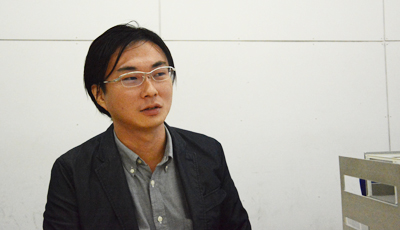
Brings forth people who can act on the world stage. . . and maybe even on Japanese variety shows!
| Department of Architecture 4th year undergraduate |
| Haruya Susa |
| Nakatani Norihito Lab |

Q Would you describe “architecture” as a Waseda “brand”? Please tell us something about it.
Studies at the Department of Architecture are not limited to design. Lines of study include “building construction,” which covers topics such as the durability and strength of buildings; “architectural production,” which specializes in the properties of materials and quality assurance; “architectural environment facilities,” which studies optimum living environments and facilities with low environmental impact; “urban planning,” which encompasses town planning and regional design; and “architectural history,” which studies the history of architecture in Japan and other parts of the world, as well as its relevance in the present and future. Each of these subjects is taught by multiple teachers who are specialists in their fields. One of the attractions of Waseda’s Department of Architecture at Waseda is the strengths that it enjoys in each of those fields.
Q What line of study are you pursuing?
Speaking of studies, I am a member of professor Nakatani Norihito’s laboratory. Professor Nakatani often says that, “there can only be history if there is someone to observe it and provide the essential connections between what comes before an event and what after.” That makes it important to grasp what takes place on a daily basis.
Architects representing Japan who came from Waseda
Q What is your field of study at Professor Nakatani’s lab?
Presently, I am studying the drawings and commentary left by Takamasa Yoshizaka, an architect who graduated from Waseda and who was active from the 1950’s to the 1970’s. Yoshizaka studied architecture under the French architect Le Corbusier, and upon his return to Japan translated many of Le Corbusier’s works into Japanese, making them available to Japanese speakers and introducing architecture of unprecedented freedom of form to the country. While engaged in this activity, he developed his theories of Discontinuous Unity and “Yūkeigaku” (Study of Form).
Yoshizaka maintained that, unlike sculpture, works of architecture are only significant because they exist against a background. For example, while windows have the function of admitting light, the choice of whether to equip a window with a curtain or a Japanese-style paper screen may vary according to the type of light with which one wishes to illuminate their life. In other words, Yoshizaka was concerned not only with the functionality of buildings, but never stopped exploring their importance in life. Not only that, but in his search of the fundamental meaning behind housing and life, he left civilization and went to places such as Africa and Mongolia to experience life from the perspective of primitives.
Q What do you want to do in the future?
I would like to find employment that will allow me to spend most of my time building architectural models. That sort of work involves building models based on design drawings. Many people think architectural models are like those you find in dioramas, but there is actually a big difference. That is, whereas diorama models are built to look real, architectural models are intended to convey the designer’s concept, and a certain sparsity of representation is usual. For example, while staircases and railings might be very precise, there may be no knobs on doors. Such models are just fine.
However, personally I am interested in building architectural models that bring out the artistic intent of the designer, rather than building them exactly as portrayed in drawings. Generally speaking, architectural models are made of paper, foam materials and wood, but they can also be made of sheet metal or glass. As drawings are now increasingly being produced digitally, I think that models you can touch have greater value. In Europe, architectural models are held in such high regard that a corner is devoted to their display at the Pompidou Center in Paris, and I would like to see such cultural appreciation take root in Japan as well.
Q In closing, please give us a message for students thinking of applying.
When you enroll in this school, you may be in for a surprise. You might think, “How can people who study so hard make so much noise? How can they behave so foolishly?” (Laughs) It is quite an unusual university.
So I hope you will concentrate on your studies until you are admitted. When you feel like you can’t take it any more, imagine what it will feel like when you are free, or imagine things you would like to do at the university and work hard on increasing your motivation.

